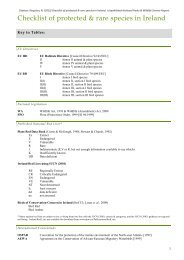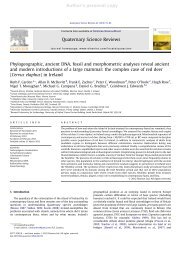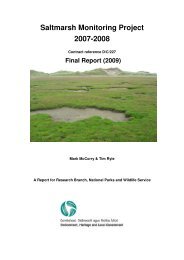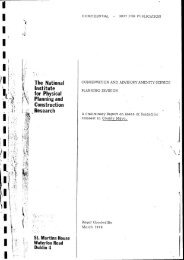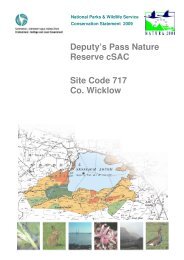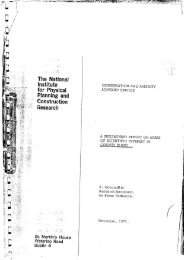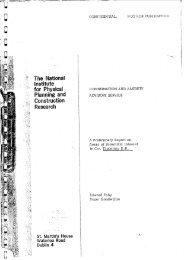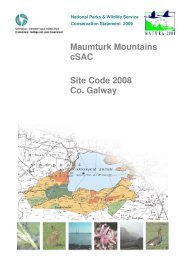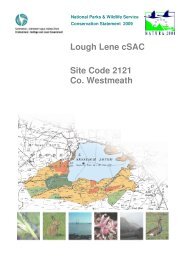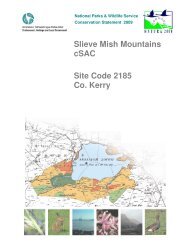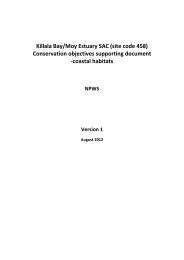The beetles of decaying wood in Ireland - National Parks & Wildlife ...
The beetles of decaying wood in Ireland - National Parks & Wildlife ...
The beetles of decaying wood in Ireland - National Parks & Wildlife ...
Create successful ePaper yourself
Turn your PDF publications into a flip-book with our unique Google optimized e-Paper software.
Saproxylic <strong>beetles</strong> <strong>of</strong> <strong>Ireland</strong><br />
____________________________<br />
FAMILY STAPHYLINIDAE Rove Beetles<br />
A small number are restricted to <strong>decay<strong>in</strong>g</strong> <strong>wood</strong>, but many are associated with fungal fruit<strong>in</strong>g bodies<br />
and the degree <strong>of</strong> association with <strong>wood</strong>-decay fungi is <strong>of</strong>ten unclear.<br />
STAPHYLINIDAE SUBFAMILY OMALIINAE<br />
Phyllodrepoidea crenata (Ganglbauer, 1895) – Rare old growth species<br />
Adults and larvae occur under bark <strong>of</strong> relatively freshly dead trees or branches, usually broad-leaved<br />
trees <strong>in</strong> England, p<strong>in</strong>es <strong>in</strong> the relict p<strong>in</strong>e forest <strong>of</strong> Scotland; they feed on fungal decay. A speciality <strong>of</strong><br />
the hill country <strong>of</strong> the N and W <strong>of</strong> Brita<strong>in</strong>, presumably also submontane <strong>in</strong> <strong>Ireland</strong>. Hammond (1980)<br />
refers to the Killarney population and the date <strong>of</strong> the first report but does not comment on whether or<br />
not there have been any subsequent records.<br />
H2 North Kerry: Killarney district, “fairly common <strong>in</strong> <strong>decay<strong>in</strong>g</strong> fungi on trees <strong>in</strong> <strong>wood</strong>s throughout<br />
the whole district, occurr<strong>in</strong>g frequently <strong>in</strong> the late Autumn months”, Bullock (1928); Deliphrum<br />
crenatum <strong>in</strong> O’Mahony (1929a).<br />
Coryphium angusticolle Stephens, 1834 – Rare old growth species<br />
Lives beneath bark <strong>of</strong> dead oak and other trees, and <strong>in</strong> red-rotten oak, mostly <strong>in</strong> <strong>wood</strong>ed areas,<br />
possibly only ancient sites; widespread <strong>in</strong> Brita<strong>in</strong>.<br />
H2 North Kerry: Killarney (Bullock 1914).<br />
H37 Armagh: Derryadd Lough, Peatlands Park, 16.iii.2002, RA.<br />
H38 Down: Holy<strong>wood</strong>, sea coast (Haliday, 1841, 1855; <strong>in</strong> a rotten stump, Haliday ms.) (Johnson &<br />
Halbert, 1902); Belvoir Forest, Belfast, 12.iv.1995 & 17.iii.1998, RA.<br />
H40 Londonderry: Culmore, CWB (Buckle, 1900) (Johnson & Halbert, 1902).<br />
Acrulia <strong>in</strong>flata (Gyllenhal, 1813) – Rare old growth species<br />
Adults and larvae under fungoid bark on sound timber <strong>of</strong> various dead broad-leaved trees, where<br />
moist <strong>in</strong>terface; general scavengers, feed<strong>in</strong>g on <strong>in</strong>sect material; adults also feed on fungal spores. In<br />
Brita<strong>in</strong> conf<strong>in</strong>ed to hill country <strong>of</strong> N and W; similarly submontane <strong>in</strong> <strong>Ireland</strong>.<br />
H2 North Kerry: Killarney, EFB (Bullock 1914), ‘the s<strong>in</strong>gle Irish record’ (Hammond, 1980).<br />
H40 Londonderry: Banagher Glen, a pair among fruit<strong>in</strong>g bodies <strong>of</strong> fungus Hymenoscyphus calyculus on<br />
oak branch, 6.xi.1999, RA.<br />
22



